
Not ready for Martha Stewart: our front yard vegetable bed.*
Some of the worst meltdowns and temper tantrums of my adult life have their origins in failed vegetable gardening projects. I thought I’d list off my top ten vegetable gardening misadventures so that you don’t have to repeat them.
1. Not paying attention to soil fertility
This is my number one mistake. Most vegetables suck up a lot of nutrients. They need lots of compost and a source of nitrogen (fertilizer, manure or a rotation of beans). The difference between our prodigious straw bale garden, which got a lot of blood meal and fish emulsion to get it going, and our obviously depleted front yard raised beds highlights this common error. I have to do more soil tests and remember to add nutrients (most likely nitrogen) before even thinking about planting veggies.
2. Planting at the wrong time of year
It took us awhile to find the right sources of information to guide us as to when to plant in our quirky Mediterranean climate (see this calendar and this book if you’re in SoCal). Seed package directions are useless here (what’s a frost date?). But, in fact, all climates have their quirks. Even two sides of the same town might have different planting dates. You have to find experienced gardeners and sources especially in places with either year round growing seasons or very short growing seasons. Ultimately, all gardening advice is local.
3. Planting things that don’t do well in our climate
Yes you can grow almost anything here, but that doesn’t mean you should. Carrots don’t like clay soils and warm temperatures. Cabbage gets lots of pests here. Some veggies are best to outsource to the professionals at the farmer’s market.
4. Not having a plan
My brain, to put it politely, is non-linear. If I were to overcome that cognitive flaw and plan out how much and where things should be planted I’d have both a steady supply of produce as well as a more attractive garden.
5. Not labeling plants
What kind of okra is that? I have no damned idea. Too bad when I want to plant it again next year. All it takes is a sharpie and a plastic knife to fix this problem.
6. Not keeping a garden diary
The two most important things to know are when something was planted and when the first and last harvests took place. With this data you can plan out next years garden more easily. Some other things to note: how did it taste and were their any pest problems?
7. Not staggering planting
I guess this is why canning was invented, but it really would be nice to have a continuous supply of veggies rather than a ton all at once. Stagger planting by two weeks, for most vegetables and you won’t have the feast or famine effect.
8. Growing things we don’t like to eat
We had a hell of a lot of turnip gratin one winter.
9. Missing the harvest
This is the most heartbreaking for me. Suddenly there’s a bunch of tasty heirloom vegetables ready to harvest. But . . . I’m going on a trip, or I’m too busy to cook . . . or I’m just too lazy to cook form scratch. It reminds me of a quip beekeeper Kirk Anderson made about beekeeping. Beekeeping, Anderson said, is like going to the bathroom, “When Mother Nature calls you’ve gotta go.”
10. Meltdowns
Vegetable gardening requires the patience of the Buddha. Crap is going to happen and you just have to accept that. Bad weather, bug infestations, marauding skunks and absentmindedness will intervene in even the best planned vegetable garden. I have at least two major meltdowns a year. Somehow, I don’t think that’s going to change.
Did I leave anything out? What mistakes have you made in your vegetable garden?
ETA: See Rule 11
*A note from Mrs. H. re: the top photo: Argh! Erik likes to be melodramatic with the pictures. Let me explain. This bed was indeed not a success. It needs soil inputs, and perhaps is hosting nematodes, so the seedlings didn’t thrive. This we realized way back in the spring. So we decided to just let that bed go for the rest of the summer and focus on the straw bales. That photo above is what a bed looks like after sitting neglected all summer long–it’s not the fruit of our best gardening efforts, or even the result of a pitched struggle. (But it did make a few tomatoes, bless it!) As soon as it cools down here I’m going to attend to that soil and bring it back to life.

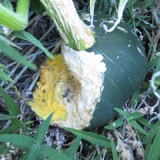
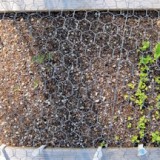
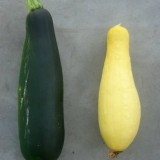
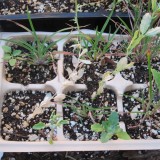
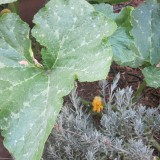
Leaving too many volunteers that spring up from the year before. I thought I would leave a few of the sunflower seedlings I saw coming up this spring. OOPs! I now have a 15′ high forest. It’s gorgeous, but it has taken over and if I don’t rouge out the seedlings next spring I will lose sight of everything.
Great Post!! #1 is so true…my garden BOOMED when I started growing the soil and not the plants!
Love your blog!
Peace, LBD
Consistent watering, especially in the arid Southwest.
Yup, this about sums up my experience. Year. After. Year. One would think that I’d remember and learn yet each year has a glorious start, with some tastiness along the way, and ends with me spending a whole day filling up an 8 foot pickup truck bed full of weeds. *sighs*
Anyho, thank you for putting a voice to our challenges.
Great list! I would only add OVER-watering. In my eagerness to take care of my veggies I often times over water. It took a while to learn restrain.
Thanks for posting so regularly. One suggestion for plant labels: instead of plastic knives, cut up discarded plastic mini-blinds (easy to scavenge from trash carts). I’ve found the table saw works well. One good-sized blind can provide a lifetime supply.
For labels I buy popsicle sticks or tongue depressors in the big box at the craft store. Unlike plastic, they biodegrade.
Water is my bugaboo — it’s so hot and dry here in July, August and September.
My biggest mistake (out of the many that I have made) was deciding to put the raised bed in my hoophouse to use in the summer (when it’s too hot to grow anything else in there) to grow sweet potatoes. I did get sweet potatoes, but I also got whiteflies…and I didn’t understand the implications of that for some time. Now I do, and I am still battling the little monsters–all over the yard– with a biological control (Mycotrol). Now, I am back to just letting the hoophouse sit empty in the summer.
To feed my soil I add some kitchen scraps to my raised beds every day……..a hole here a hole there in goes the veggie scraps. I also make a mild tea using Broadleaf Thyme(Coleus amboinicus)and wet the soil with it every 2 or 3 days. The plants seem to love it and it makes a great insecticide…….I dislike the word insecticide:(
My biggest mistake is snipping off from my herbs plants to soon. I just cannot seem to stop myself. Now I found out that having 3 plants of each herb allow me to snip from one while the other two are growing.
Have learnt a lot from reading your blog, thanks a trillion:-)
I love the idea of adding scraps to the raised beds – Brilliant! Thanks!
Guilty of all of these, especially the nutrient deficient soil this year. I curse myself and then whine about not having enough cukes to make delicious pickles. Must build the soil! Good reminders!
Do you try plant rotation for soil fertility? I have dabbled in peas but haven’t had a ton of success.
Also do you have tips for staggering planting? I grow from seeds and I find it is really inconvenient and space intensive to start the seeds 3 or so weeks apart. But starting the seeds all at once and staggering the seedlings means the later seedlings are a little bit leggy and stunted.
Also, I have found the easiest solution for excess harvest. Puree fruit with cinnamon or honey and some lemon juice and spread it thin on parchment paper in the oven at 175 for 5-6 hours. Makes fruit jerky or fruit leather, depending on the initial fruit used. Might also work with savory stuff like zucchini, unfortunately all my zucchini went to seed while I was on vacation.
My biggest mistake was to not cage my tomato plants early enough. It was so cold and wet here this spring that they barely grew the first month they were out, and I admit, I got complacent. Later, I managed to wrestle some of them onto some supports, but did some damage along the way. The small fruited varieties didn’t suffer, but the brandywines are kind of a mess and I know it hurt productivity.
Great list. I’ve been guilty of most of these at some point.
I’d add some manner of automated watering system. When I get lazy and think I’m going to “water everything by hand”, things inevitable get overlooked and the plants suffer. The investment of time to set up soaker hoses or drip irrigation pays itself back tenfold.
Thanks for sharing your mistakes…it helps me as well because I tend to make the same mistakes over and over again! My biggest one is to not weed enough. I hate weeding, especially mid to late summer. We mulched super heavy in our small garden and I hardly had to weed at all. Our community garden is another story. We mulched heavily (newspapers, mulch, grass clippings) but it’s a jungle over there. While it’s much more under control, we’re planning on lots more newspapers, leaves and straw over winter. I guess failures come from knowing our own weaknesses. Thanks for the article! (I shared a link of my own post for 5 top garden failures.)
http://livininthegreen.blogspot.com/2013/07/my-top-five-garden-mistakes.html
Love your reflections and advice!
I find that one of the things of
which I’m most guilty for unsuccessful crops is not marking the seeds that I saved!! This spring, I mistakenly planted 12 Madagascar spinach seeds instead of what I believed to be Okra seeds…I had conveniently used an empty okra seed packet, then forgot about it…not the first time this kind of thing has happened.,,So, tons of vining spinach! Thank goodness it does well in heat, too, unlike the true spinach!
Madagascar spinach?? That sounds cool! You just turned me on to a new variety!
(Oh, and I do the same thing – except with beans. Throw them in an envelope and forget to label. It’s a crap shoot to see what pops up.)
Your turnip gratin comment made me chuckle.
When we put in our current garden several years ago, I decided I wanted to try horseradish. So I planted several horseradishes (they’re related to cabbage, except they grow to about 5′ tall), which are perennials that ended up seeding a very large area – much larger than I would have guessed. And I clearly overestimated the amount of horseradish our (or any) household could possibly use. Luckily, the plants themselves don’t have that distinctive piquant bouquet, and neither do the roots, until you grate or slice them very finely, making removal a chore but not an actively dangerous one.
…if you ever try horseradish gratin, let us know.
Your post here makes me feel so much better. I have hit myself over the head for nearly all these mistakes at one time or another especially when I see those beautiful blog of lush plants. Sometimes I have asked myself why I continue to garden since I seem to get lazy about it, forget to pay attention, have to battle with the weather/bugs…etc, etc, etc. But every year I do it again so I am either compulsive, hopeful, or insane. I would like to think that it is ‘hope springs eternal’.
Mistakes!! I planted my tomatoes too close together in a corner up against the fence – bring on the bacterial blight! and I planted several of one variety that I don’t like, but can’t find the label for. and once again I ordered a few tomato plants from a catalog – they are always too small. these were grafted early girl, which is so far my favorite variety, but they were $8 each and didn’t perform well enough to merit their cost.
one fall I planted lots of bok choi, which did great. Wow did I get sick of it. I kept trying to share – no one seemed to have heard of it.
I love Bok Choy-send me your overstock!
Great list – here in LA, during the summer months, I am guilty of not watering my raised beds enough….and get some pretty sad crops.
Also – as another poster noted – leaving too many volunteers.
Finally, I have this silly idea every-single-darned-winter to throw out handfuls of flax seed in the yard. I love the flowers, but come springtime I have masses of flax. Will I never learn?
I just don’t have the knowledge to develop this kind of insight when things go wrong. But, it is refreshing to have someone admit to garden foibles.
I am guilty of most everything, too, but since I hate weeding and being confined to watering everyday as I have two big gardens as I raise food for a food pantry also. I found some carpet that was trashed and cut it to lay close to my plants down both side of my rows and in some places my paths for water melons and pumpkins. Not only did I not have to weed, but the carpet didn’t allow the water to evaporate as easily the ground stayed wet, insects had a harder time to get to my plants and actually eliminated many pests completely, but the best part was I had much more time and when I wanted to go fishing I would raise a couple pieces of carpet and the worms of all sizes would be laying there in the cool wet ground so I didn’t have to dig them up or spend money buying them (I had more in my garden then ever before). The only problem I had was after the garden was finished I would have to pick the carpet up along with the stalks and stems. I was still able to fertilize and out of 15 cucumber plants I stopped weighing at 749 lbs of cucumbers. I started getting better yields this way. I ask carpet stores where they are putting in carpet and sometimes they will deliver it to me.
That is an inspiring story – I grow lots of cukes every year for pickles. I make a spicy hot version of Polish dills that we adore. I wonder if this would work with other fabric – I have lots of canvass drop cloths that are somewhat torn up and I hate to throw them away. I know they wouldn’t be nearly as heavy but I am gonna try it anyway.
thanks for this!!!
my mom and I kept coming across this tip and i just wasnt sure about it…but i think we will definitely try it now!
Trish Oh the spicy hot version of Polish Dill Pickles sounds so goood. It worked for all plants including tomatoes, okra, cabbage and everything else. Bugs and caterpillars don’t climb the plants as they don’t like the carpet.
prb I use the thin not shag carpets as I don’t want to have to weight them down and I made the mistake of trying to use the padding under carpets one year and when I went to clean it up, it fell all apart and I made more work of cleaning it up than carpet. The canvas drop cloths might blow away depending on how heavy they are between watering. The carpet always seems to stay damp and will never blow away. I hope this helps you all as much as it helped me.
i use my excess kefir water in my plant water for my potted plants….they seem to like it….but watch out using it indoors – the ants also love it.
and speaking of which…i inadvertently brought ants into the house last year when i brought my potted plants/cacti back in for winter. i’m still trying to nicely get rid of them….the diatomaceous earth (sp?) is great but my cats track it everywhere.
Source of good garden journal:
http://www.leevalley.com/US/Garden/page.aspx?p=43043
It really helps to have a dedicated diary, well laid out and formatted for gardening. Keeping weather notes and using a min/max thermometer helps, too.Takes 5 minutes/day before brushing teeth to fill it out.
It can be a bit discouraging at first to see all those blank pages but once you hit the year mark you can start making comparisons and then it gets interesting.
Using a planting guide like this (http://www.vintageveggies.com/information/planting_guide.html) is helpful to keep track of dates and keep from planting too much/not enough.
Pingback: Make that 11 Vegetable Gardening Mistakes | Root Simple
Pingback: Brain Tastes From the Interwebs | Jeff Parker Cooks
Pingback: Top Ten Vegetable Gardening Mistakes | Alabama Survivalist
I read the article, and all the comments. I would like to humbly offer an opinion. You should read Fukuoka’s books – at least read The One Straw Revolution. What everyone here is doing is exerting control and trying to direct Nature, instead of letting Nature do the work. This will always result in failure – great or small.
I live in the desert – I grow almost all my own food. I do not fertilize, I do not have to water – I do almost nothing. I mix all my seeds up in a bowl and throw them into the fields. I cover them with a light covering of straw. I wait. I let Nature do the work. I have very little pestilence or disease problems. Grow cover crops and then let them become mulch. Adding a little straw and hay between seasons. This is all you need to do. Put your table scraps “under” the mulch. It will compost itself. Think about the forests. Do they get fertilized? No.
Let’s take Russian Comfrey as an example. It sends tap roots down 15 feet. Anything growing near it benefits as those roots bring up all the goodies stored down there to feed them. Acacias. Same thing.
If you just are growing a small hobby garden – probably all you need to do is read one of Ruth Stout’s books.
You can never be smarter than Nature. You are trying too hard. Let her do the work.
In which kind of climate and soil are you working? Do you have pictures of “putting seeds up in a bowl and throw them into the fields” with time laps results?
My mistakes… planting things too close, letting volunteers stay, not having big enough cages for tomatoes. I wind up with a jungle of tomatoes and nothing but watermelon vines underfoot, and nothing else has a chance.
Pingback: Friday Favorites :: 9/13/2013 | Homespun Seasonal Living
I had the worse garden ever this year. We moved to a new home, which has alot of walnut trees. I assume this is the culprit of scrawny plants and dwarf type fruits. Can anything help?
Black Walnut?
Black walnut can be a problem for some plants, but not all. This list might give you an idea:
http://www.groworganic.com/organic-gardening/articles/companion-plants-that-tolerate-black-walnut-tree-toxicity
So if you have plants which are supposedly not bothered by the walnuts doing poorly, you have to search for another cause. Consider your soil fertility–that’s what I’d look to first. Mulch, compost, amend — as per your preferred school of gardening.